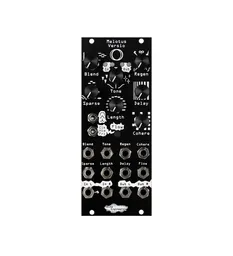Today we have the joy of having a guest post from the person behind one of the most listened-to acts here in the NE house, Blakmoth. We have previously featured Jack on the Noiseblast Hour, but that’s just the tip of the iceberg. Blakmoth is one of the most prolific artists we know, and his Bandcamp is almost constantly updated. We’re pleased to sit down with him to chat about his background, his inspirations, and doombient, the genre / movement he has created.
Kris Kaiser: Thanks for talking to us today. Tell us a little bit about yourself.
Blakmoth: My name is Jack and I create and compose under the project name Blakmoth. I’m a full-time musician working my way into film composing.
Music has always been a part of my day-to-day life. At a young age I learned that music was my go-to therapy when it came to being well, I could sit and listen for hours and everything would be right in the world. In times of high anxiety or the darkest low I can always find peace of mind in music.

You talked in your Noiseblast interview about being a military kid moving around the US and the world growing up and how that impacted you and your interest in culture. Have you been influenced by the music of those places?
I’m definitely a worldly person because of it. I’m very interested in other cultures and their religious views and way of life. That aspect has definitely influenced my music.
You also talked about your grandfather who was a one-armed jazz organist. How did your relationship with him influence your music trajectory?
Everything I am musically came from the love and nurturing from my grandfather. When he passed, I found it hard to create music and took a long break. I soon felt the path I was on in life was wrong, but when it came to music, I felt at home. When I create. I remember the times when I was little and though everyone else felt I was just making noise, my grandfather would always smile and enjoy it. I feel that same smile on me while I create now.
I’ve talked to a lot of people who have lamented the lack of diversity in modular. It’s getting better and you’re one of the people at the forefront. Is there anything you’d like to say about being a minority in modular synthesis?
Being a minority in modular synthesis feels like a special role. I hope to inspire others. Growing up I received a lot of ridicule for my interests in “culture” outside my own. I was often called a sellout or told “ you think you're white” just because I dressed differently and enjoyed Techno and Rock music. When I first arrived on the music scene it was making lofi hip hop because I fell into a trap of thinking that was my place. But then I saw artists like Ali The Architect, VoltageCntrlR, and Lafrae Sci and realized there is a place for me here. It was Lafrae who educated me on the history of Techno and Afrofuturism which let me know not only did I have a place but a right and I represented something far greater than I thought I did. It’s amazing to get messages from other POC artists recognizing that they don’t have to be stuck in a box of doing what is considered the norm and are inspired to not only make Techno, Experimental or otherwise but also get into modular. It’s something I’m extremely proud of, that I put a special effort into encouraging. [ed note: in case you don’t know, La Frae also runs Willie Mae Rock Camp. Check it out -- what they do is incredible and worth supporting]

You are known for the genre you founded, Doombient. What makes Doombient, and where does it come from?
Doombient comes from a combination of my favorite genres of music. Ambient, industrial and Doom Metal. Both the dark and droning doom as well as it’s sorrowful melancholy counterpart.
I love drone and ambient music. It’s what inspired me [to get into] modular. At the time, I felt everyone was doing the same thing there was a vibe. A good one, but I felt that it would be cool to introduce something different. Maintain the elements of ambient but darken it up. Instead of plucky melodies and reverberating pads let’s go for a dark brooding sorrow that still can be beautiful.
Where do you get your inspiration for your compositions? Do you find yourself pulling more from current emotions or past ones?
When I sit and create it’s all personal emotions. I aim to recreate a feeling. It’s interesting because it’s mostly the past: things I’m dwelling on or haven’t let go of. Feelings of loss or nostalgic memories. There’s no melody or planned concept. I start with a blank surface and work my way into triggering the desired emotion. I want my music to make you feel, to connect with you directly.

What's your favorite NE module and how do you use it?
I have to say Manis Iteritas is my favorite module. From day one it had my heart. It checked all the boxes of my Doombient aspirations.
I mostly use Manis for melodic patching. Mostly because I had BIA at the time. I’ve recently found joy in the Liquid mode. It’s like having a meaty kick with a synth hit attached. Or you can open up the envelope and Mmmmmm. I love it.
Walk us through a recent patch: what you did, and your intentions.
I have a default with Manis: it’s always modulated by one or two Clep Diaz LFOs. When patching rhythmically I put them both in random step mode and feed them two different clocks or polyrhythms. In the case of a drone piece I’ll switch them to lfo mode. Manis is also triggered by a third clock as well as Vox Digitalis cycling pitch. Then it goes to Viol Ruina and out to Desmodus Versio. This is the case in “Cavity” I always visualize Manis as an ebb and flow of dark waves so I often patch it to match.
What artists are your biggest inspirations?
Major influences for me are Alessandro Cortini, Sunn O))), Trent Reznor and Atticus Ross as well as a large portion of the musicians I follow on Instagram. They make up 90% of my music collections and playlists.
You’re an extremely talented graphic artist. How does this background influence or work its way into your music? (If you haven’t seen some of Blakmoth’s art, check out his instagram page. There’s some incredible stuff.)
I went to school for graphic design and a lot of what I learned about influencing with an image I apply to my music. There are no lyrics so I have to convey my art through sound.

Tell us a bit about your workflow. You are extremely prolific. How do you release so much music? When is the next release?
I try to keep it efficient. I want to just sit and speak my mind. So I’m most cases it’s relatively DAWless. It often starts with patching that feeling then once I hit that nerve it all gets recorded onto tape or tracked out in the DAW if it’s score work. Any mixing and mastering is done as I create. I want my sound to be as raw and untampered with as it can be. If it is unpolished it’s because it was designed that way.
I’m always creating. I get up around 6 and I spend most of my day patching and learning. I record all of these sessions, and clips of those become Instagram posts. If I have an album to work on, I spend a whole day working at it. I work in the moment, so for an album to have a consistent vibe, I just have to get it done within the span of that emotion.
I’ve laid my setup out to match my workflow down to module arrangement moving from right to left. I often start with an “environment”: this comes in the form of a field recording or tape loop of textured sounds. Then I add in my voices, modulate, and record. Because I’m often maintaining a vibe, I don’t reset the rack for albums. I simply adjust or repatch the modulation and pitch over a new “environment.” Maintaining the creative flow is essential here as I’ll make track after track until I have about 20 or so. I select a few for a release and leave the rest for the next. Because I’m working daily, there’s lots of overlap so I have tons of music for releases.
Upcoming is a collaborative album with An Moku (TBA)
If you like Jack’s music, find more Blakmoth in all the usual places at the links below. Be sure to subscribe on Bandcamp for everything Blakmoth, including subscriber exclusives.
INSTAGRAMBANDCAMP
SPOTIFY
APPLE MUSIC




